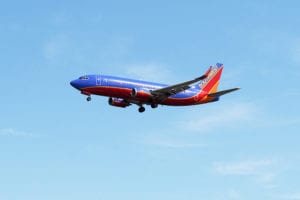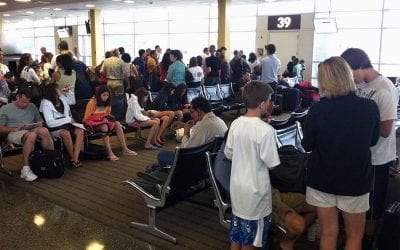The 2022 airline complaint data logged by the DOT was damning for airlines. It showed a huge increase in complaints about cancellations and delays.

In 2021, DOT received 49,991 airline complaints, but in 2022 they received 77,656 complaints, a whopping 55.3 percent increase. Of the 2022 complaints, 31.7 percent concerned flight problems, 25.7 percent refunds, and 15.5 percent baggage.
Shortages of pilots, other airline and airport personnel, and shortages of air traffic controllers are much to blame for the cancellations and delays.
Why are the airlines having such a problem? A major cause of delays and cancellations is the pilot shortage. While the shortage of qualified pilots for scheduled commercial airlines has eased somewhat, it’s still substantial. According to expert Oliver Wyman, there will be a serious pilot shortage during the next ten years averaging 17,000 pilots, with a gap in 2026 of about 24,000 pilots.
There are also shortages among other airline and airport personnel. In addition, the FAA is experiencing a shortage of air traffic controllers. Nationwide, 20 percent of air traffic controller slots remain open. The union representing air traffic controllers says staffing levels have dropped by about 10 percent over the last decade.
The current flight cancellations and delays will likely continue for at least a decade.

As air travel consumers, we must heed the hard lesson from the DOT report. We must plan and book our air travel defensively. We need to take a strategic approach that can offset the problems to the extent possible. I have a seven-part strategy I’ve employed for years to help me avoid cancellations, baggage problems, and late arrival. It’s still valid today.
Here are the seven parts of my strategy to minimize the problems of airline cancellations and delays.
Fly from an airline hub:
Flying from an airline’s hub can help avoid the effect of cancellations and flight problems. Hubs handle hundreds of flights daily, typically with many destinations having multiple flights daily. That means if your flight is canceled, you have a better chance to still fly to your destination on the same day as your original flight. Hubs are often home to crew bases. If a flight is delayed and the hub contains a crew base, if the original crew times out, your airline may be able to get a substitute crew instead of canceling the flight.
Book the first flight out:
I know waking up for an early AM flight may be tough, however, those first flights of the day to destinations often have the best record of not being late or canceled. Typically, early morning flights are on planes that arrived the night before. As a result, they’re generally not at the mercy of problems at other airports or the vagaries of weather.
Reviewing the data from the 30 largest US airports shows that flights are scheduled to leave between 6 and 8 am. On average, 25 of the 30 largest US airports are on-time more than 80 percent of the time. The on-time record of flights later in the day is typically much worse.
Booking nonstop flights helps mitigate cancellations and delays and helps ensure your checked luggage arrives with you when you land at your destination.
Book nonstop flights:
If you’re only flying nonstop to your destination, you have a greater chance of your air travel not being disrupted. If you book connecting flights, you introduce the potential of delays and cancellations to your final destination. An added benefit of booking a nonstop flight is that any checked luggage you might have won’t have to be transferred to a second or third plane, reducing the chance your bag(s) will be lost or delayed.
Give yourself plenty of connection time if you can’t fly nonstop:
You can’t assume everything will go perfectly any time you fly. I keep hearing from airlines that connection times of 45 minutes are sufficient. They’re not, particularly on routes that have chronically late flights. Frankly, I try to use connection times of at least a few hours domestically, more internationally. You don’t know what’s going to happen.
Avoid checking bags for short trips:
When I fly, I often need to check a bag because I bring my essentials, clothes, and photographic gear in my carry-ons. I have them in my carry-ons because they’re essential, valuable, and/or breakable. Airlines assume no liability for valuables and breakables in your checked luggage. It’s codified in every airline’s Contract of Carriage, the contract with the airline you agree to follow when you purchase your ticket. If your flight is canceled, there is no guarantee that your checked bag will make it to your next flight, according to when it is, or that the airline will retrieve your bag promptly from the plane if you need it while you wait for your next flight. However, if I’m on a weekend jaunt, I ensure I fit everything in my carry-ons.
Avoid airports with poor on-time records and high cancellation rates:
According to InsureMyTrip, the worst airports for cancellations in 2022 were Buffalo, Fort Myers, Laguardia – New York, Newark, and Reagan National Airport – Washington, DC Most flights at these airports are on time. They are more likely than others to have cancellations.
Checking airline flight/route reliability is critical in choosing flights that will get you to your destination on time and with fewer overall problems.
Check airline flight reliability:
We know from the DOT report that the highest percentage of canceled flights were on Southwest Airlines, Alaska Airlines, and Allegiant Air. We also know that American Airlines, JetBlue Airways, and Delta Air Lines had the lowest rate of flight cancellations, but that information is too general to use.
It would help if you discovered your flight’s reliability before booking it. I typically rely on Flightstats by Cirium, but if you want free information, go to the DOT Bureau of Transportation Statistics, Summary Statistics Flight Number data. The DOT information and Flightstas will give you on-time and cancellation history information.
If you haven’t been thinking about the problems of how flight cancellations and delays can harm or end your trip before it starts, I hope this year’s complaint data from DOT is an eye-opener. Use my seven-part strategy to lessen the impact of air travel problems caused by flight cancellations and delays on your journeys.

READ ALSO:
Why passengers need common airline flight credit rules
Airline fees disclosures in aviation IT and artificial intelligence
After many years working in corporate America as a chemical engineer, executive and eventually CFO of a multinational manufacturer, Ned founded a tech consulting company and later restarted NSL Photography, his photography business. Before entering the corporate world, Ned worked as a Public Health Engineer for the Philadelphia Department of Public Health. As a well known corporate, travel and wildlife photographer, Ned travels the world writing about travel and photography, as well as running photography workshops, seminars and photowalks. Visit Ned’s Photography Blog and Galleries.



